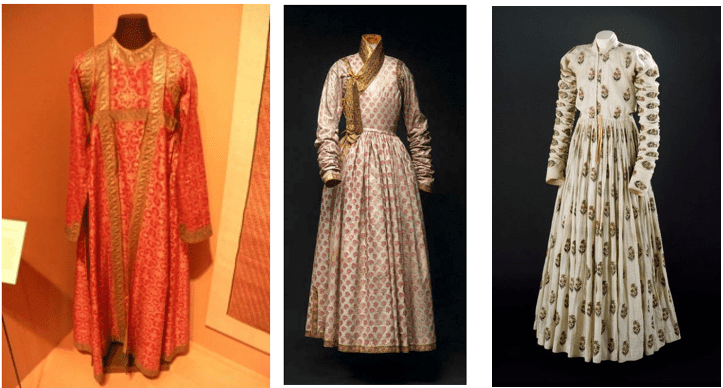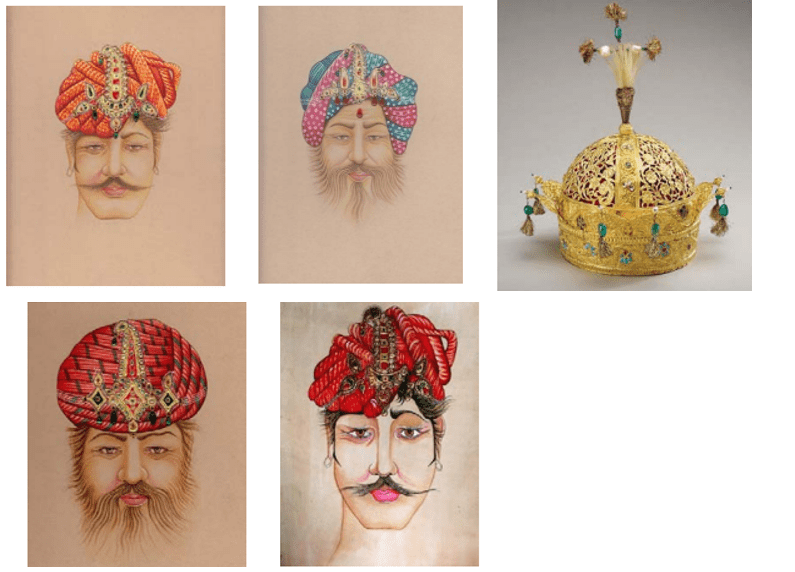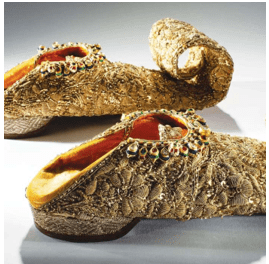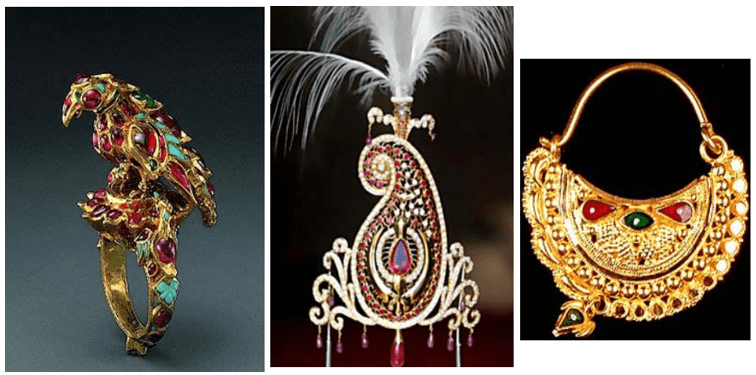Introduction
The “golden time of Indian History” is referred to as the Mughal era. They brought their culture, religion, and customs with them, which had an impact on the jewellery and clothing of the time. The tailored salwar kameez with Mughal influences gained popularity. Dresses were made by skilled master craftsmen and labourers who were imported from various nations. During Akbar’s rule in the 16th century, dresses were made up of a knee-length coat and a full skirt. The creator of brocade was Jahangir’s wife, Noorjahan. Initiating the cottage business, Noorjahan had her clothing produced in the chikenkari technique. Under the support of the Mughals, the textile industry flourished. [1]
The term “Mughal attire” refers to clothes created by the Mughals in the Indian subcontinent throughout the 16th, 17th, and 18th centuries. It was fashioned with muslin, silk, velvet, and brocade and had opulent designs. Cochineal, sulphate of iron, sulphate of copper, and sulphate of antimony were employed as colours in intricate designs that included dots, checks, and waves. [2]
Textiles used
During the Mugal era, a range of materials were employed, from light brocade to delicate muslin. Most often, silk was used to make the king’s clothing. The veils were made of nets. There were also threads made of gold and silver. At the time, textiles featured light and warm wool, pashmina, and wild goat’s hair fabric (tus). Silks were frequently laced up and decorated with gold and silver thread. [1]
Although it’s common to assume that wealthy people like silk materials, fabrics made of wool, cotton, and goat hair were also extremely valuable because of their appealing textures (softness, warmth, etc.). Textiles were prized in Mughal India for a multitude of reasons, including the monetary worth of the materials, the sensory appeal, the metaphorical and symbolic links, and the socio-political connotations.
These clothes were all frequently perfumed with rose water. According to legend, shawls were so thin that they could fit through a finger ring. The various muslins were given lyrical titles like “woven air” and “flowing water,” respectively, such as ab-i-rawan and daft hawa. Each item would lose its functionality after just one use.
Mughal Costume
- Both women and men in the Mughal empire wore pricey, luxurious clothing made of the finest fabrics, and they were completely covered in jewellery.
- The finest muslins, silks, velvets, and brocades were used to create the clothing worn by Mughal women. These muslins came in three varieties: Ab-e- Rawan (flowing water), Baft Hawa (woven air), and Shabnam (evening dew).
- Shabnam Muslins, known as Dhaka malmal, were imported from Dacca.[1]

Mughal Men’s Clothing[1]
Mughal mens clothing
- The Jama: The Yaktahi Jama (an unlined Jama) was first worn over a pai-jama to create the “Bast Agag” ensemble in Iran and Central Asia. It was worn both long and short. The word “Jama” in Persian denotes a dress, robe, or coat. The Mughal Jama is a side-fastening frock coat with a fitted bodice, cinched waist, and a flaring skirt that falls to the knees.
- The Chogha is a very old garment that can be found in many cultures, including Persian, Mongolian, and others. During the Mughal era, a long coat with open sleeves that was typically hip- or knee-length was referred to as a chogha.
- Dhoti and Paijama: Men always wore pants with their jamas (coats in this context), and there is no artistic evidence to imply that dhotis were ever worn with the jackets during the Akbari period. As a result, Rajpal wore trousers in public even if he may have dressed in a dhoti at home. Artwork from the era show that the paijamas were flowing and loose up to the knee, when they tightened up till the ankle. Often, the cloth on the lower legs is wrinkled, indicating that the paijamas were pushed up, like the sleeves of the jama, in a show of ostentatious consumerism because they were longer than the leg itself.
- The Patka: A long, thin piece of fabric was tied around the Jama’s waist in the manner of a sash. This was the Patka, from which a sword encrusted with jewels could be dangled. Patkas were intricately woven by hand, embroidered, hand-painted, or printed. Several pieces designed for royalty exhibited the highest textile artistry.
- Turban or Pagri: An Indian man’s turban, which announced his rank, religion, caste, and place of origin, was his most crucial accessory. The loss of a turban was the most degrading punishment a man could endure. To yield a turban to anyone was a show of complete subjugation. [1]
Mughal women’s clothing

Mughal Women’s Clothing[1]
- Peshwaz: Loose, jama-like robe with a front closure and ties at the waist. often large sleeves reaches the floor that typically has short sleeves or sleeves.
- Pai Jama: This word is a combination of the Persian words “pai” and “jama,” which both imply covers or legs or feet. Since very early times, people in Persia have sported drawstring pyjamas. Several styles of pai-jamas were worn in India from around 1530.
- Yalek: A long under-tunic that reaches the floor and typically has short or no sleeves
- Churidar: worn by both sexes, this garment is cut on the bias and is substantially longer in length than the leg.
- Shalwar: A pai-jama with a triangular cut and a quilted band (poncha) at the ankle worn by both sexes.
- Dhilja: A wide, straight-cut silk pai-jama for women.
- Garara: A woman’s pai-jama with the knees cut loose and gathers added.
- Farshi: A woman’s pai-jama that is cut straight through the knees and then pleated to the floor.[1]
Headwear

Headgears [1]
The classic Mughal turban, which did not have a kulah (cap) and involved a tight bundle in the front and an upward slope backwards so that it bulged near the back, became popular during the reign of Akbar. To keep the turban in place, a turban band or sash, which is often made of a material other than the turban itself, is put across the head. [3]
- Turban: The Mughals decorated their turbans by tying on bejewelled bands, wearing jewellery on their pins, and wearing various ornaments.
- Caps: There were many different kinds and lavishly adorned caps used. The Chau-goshia was created in four parts. Qubbedar is a dome-shaped star. The boat-shaped Kashi ti Numa The Dupalli is a tiny, narrow cap with points at the front and back. For nobility, there is the elaborately embroidered Nukka Dar. The Mandil is typically black velvet with gold or silver thread embroidery. [1]
.Footwear


Charhvan Salim Shahi
Both men and women wore decorated shoes with turned-up toes (Jhuti), a Persian fashion. Other shoes included the Charhvan, which had a curled tongue attached to the toe, the Salim Shahi, which was ornamented in gold, and the Khurd Nau, which was made of child leather and was very light. They were all worn by nobles and monarchs. During the Mughal era, Lucknow was most well-known for its footwear, and the technique of Aughi, which involves embroidering leather and velvet shoes, was particularly well-liked.[1]
Jewellery

Jewellery
Turban jewellery was regarded as an Emperor’s right. The design of the turban jewellery demonstrates the ongoing evolution of European influences. Akbar maintained an upright feather plume at the front of the turban in accordance with historical Iranian fashion. Jahangir introduced his own gentler aesthetic with the plume that was heavily loaded with a huge pearl. Its form spread throughout the country by the reign of Aurangzeb. Turbans were frequently highly encrusted with gems and held firmly in place with a gem-set kalangi or aigrette, which was modelled after the aigrette worn by the Sultan of Ottoman Empire. Men frequently wore Jigha and Sarpatti, Sarpech, Kalgi, Mukut, Turra, and Kalangi as head ornaments. Several head ornaments, including Binduli, Kotbiladar, Sekra, Siphul, Tikka, and Jhumar, were also worn by women. In addition to these, braid ornaments played a significant role in women’s head jewellery. [4]
Furthermore very popular throughout the Mughal era were ear jewellery. Earrings have seen frequently in Mughal paintings. Both men and women adorned their ears. Among of the well-known earrings from the time are Pipal patra or papal patti, Mor-Bhanwar, Bali, Jhumkas, and Kanphool.
Both men and women wore neck jewellery made of various types of pearls and precious stones. Men’s neck jewellery options were Latkan, an amala necklace, and Mala. The jewellery worn by ladies also includes neck decorations such as Guluband, Hans, Har, and Hasuli. Women were the only ones who wore nose jewellery. During the Mughal era, ladies adorned their noses with a variety of nose decorations, including phul, besar, laung, balu,
nath, and Phuli. [4]
Impact of Mughals on Indian Culture
Parts of India were dominated by the Mughals for a very long time—300 years, to be exact. The Mughals were, in the end, foreign kings. They were Turkic-Mongol in origin, and they carried with them Central Asian traditions and cultures.
What is the most obvious representation of culture and identity today? what is appropriate to wear. And the Mughals had the biggest impact. Simply put, they altered how Indians appear. The Mughal era produced a large portion of the modern clothing. In reality, four aspects of Indian clothing are a legacy of the Mughal era.
Reference
- Mughal period costume – invertis university. (n.d.). Retrieved February 16, 2023, from https://www.invertisuniversity.ac.in/pdf/Institutional-LMS/Fashion%20Designing/MUGHAL%20PERIOD%20COSTUME.pdf
- Fun Facts for Kids on animals, Earth, history and more! DK Find Out! (n.d.). Retrieved February 16, 2023, from https://www.dkfindout.com/us/history/mughals/what-did-mughals-wear/
- Houghteling, S. W. (n.d.). The emperor’s humbler clothes: Textures of courtly dress in
- Abraham (2007). The Mughal World. New Delhi: Penguin Books India. pp. 139–142. ISBN9780143102625.

